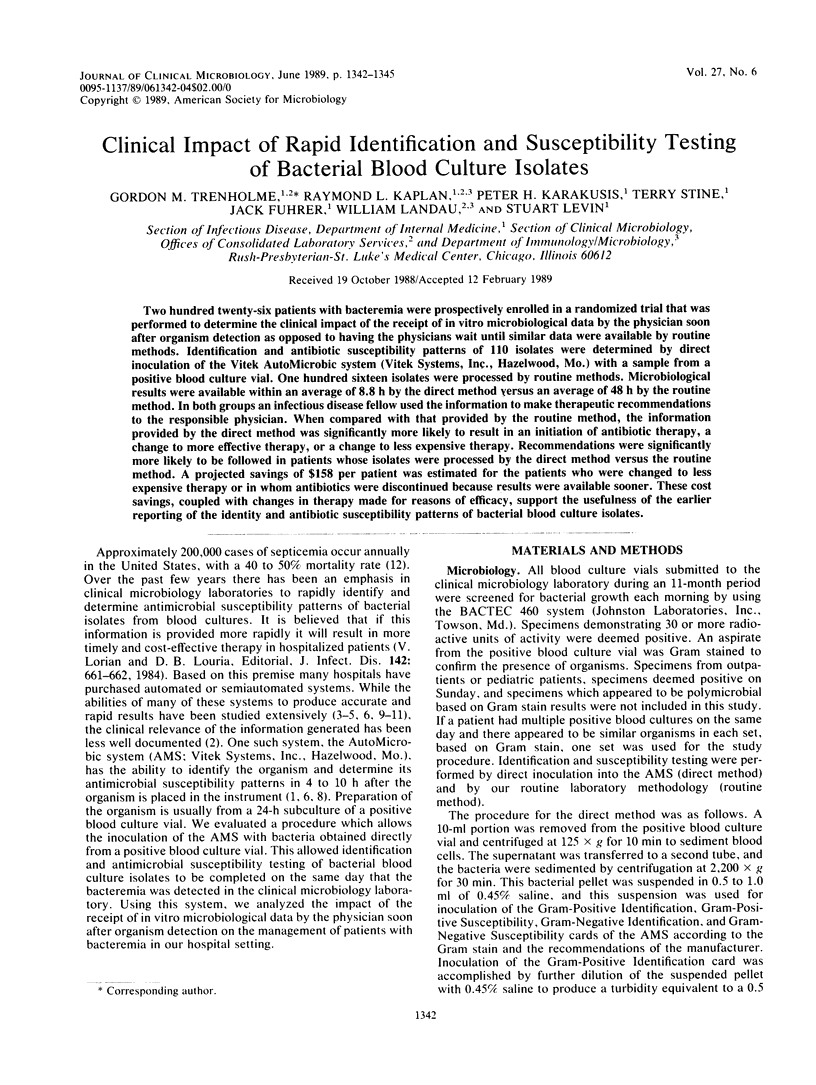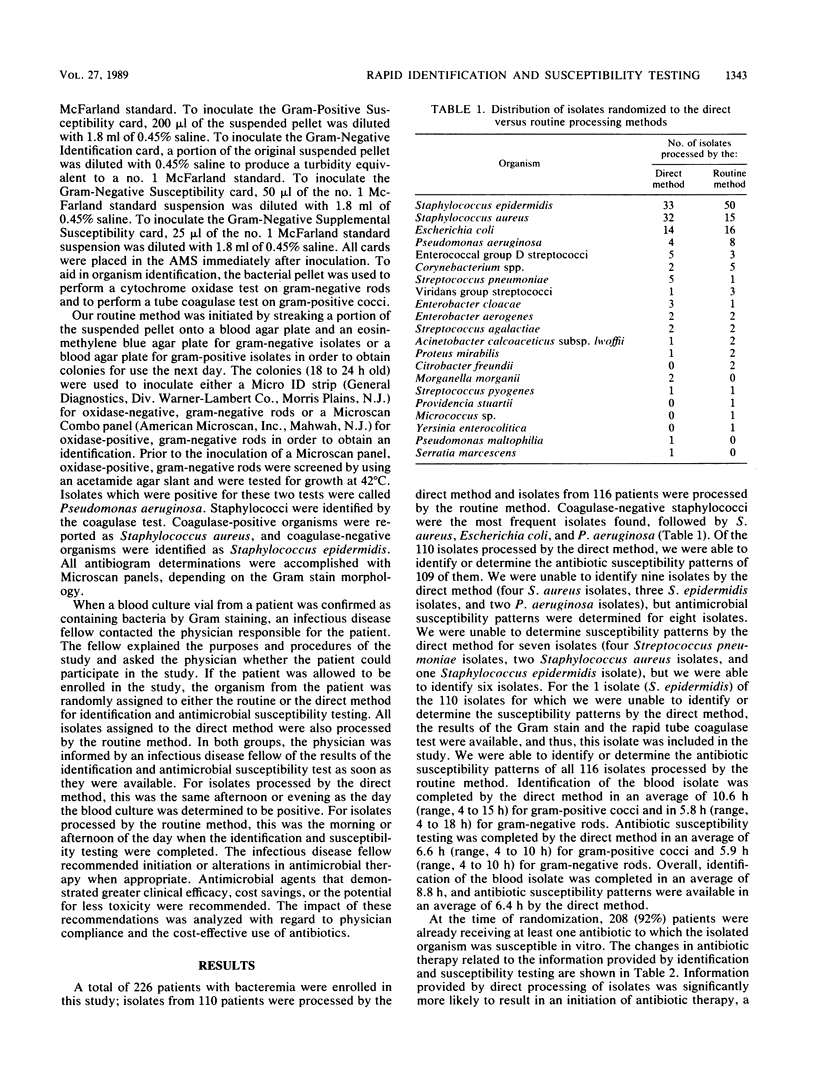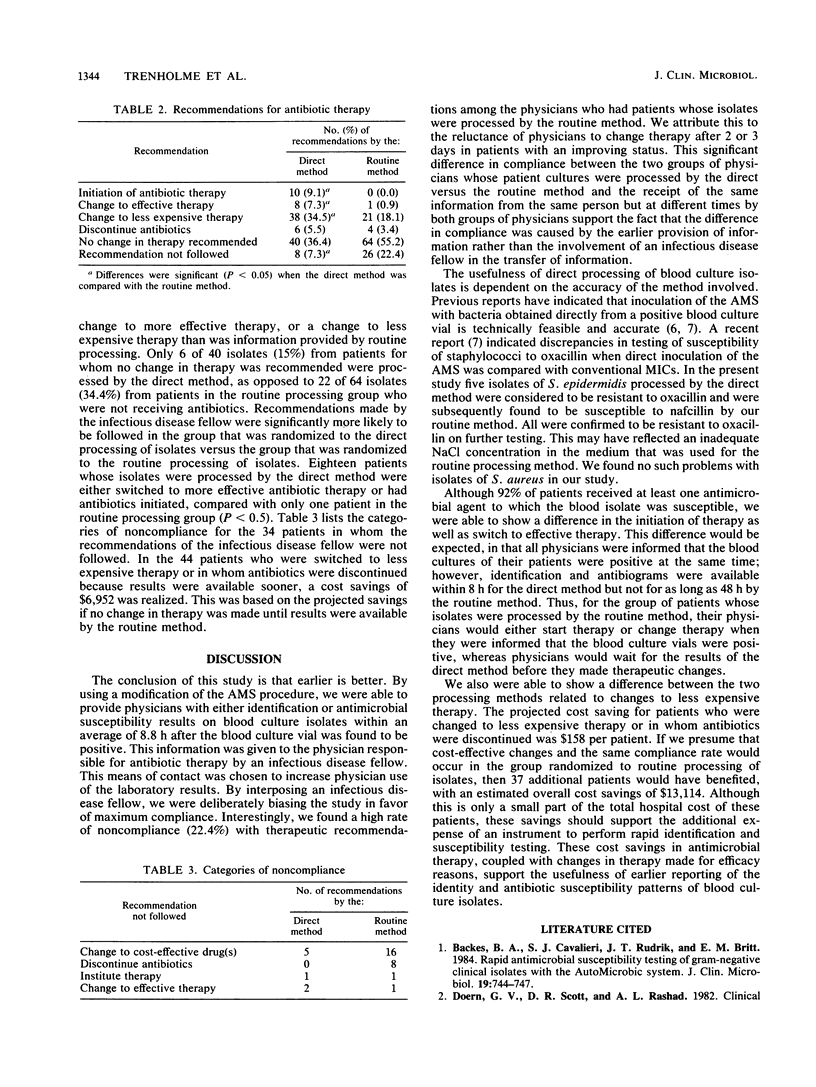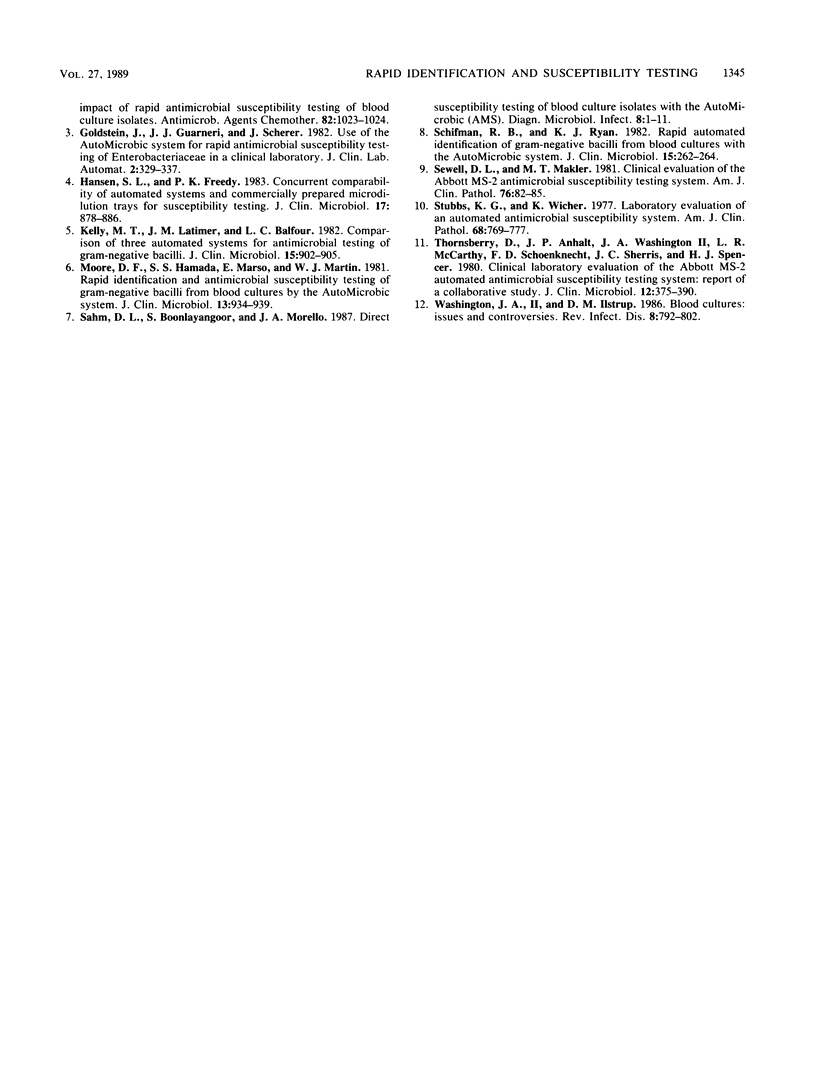Abstract
Two hundred twenty-six patients with bacteremia were prospectively enrolled in a randomized trial that was performed to determine the clinical impact of the receipt of in vitro microbiological data by the physician soon after organism detection as opposed to having the physicians wait until similar data were available by routine methods. Identification and antibiotic susceptibility patterns of 110 isolates were determined by direct inoculation of the Vitek AutoMicrobic system (Vitek Systems, Inc., Hazelwood, Mo.) with a sample from a positive blood culture vial. One hundred sixteen isolates were processed by routine methods. Microbiological results were available within an average of 8.8 h by the direct method versus an average of 48 h by the routine method. In both groups an infectious disease fellow used the information to make therapeutic recommendations to the responsible physician. When compared with that provided by the routine method, the information provided by the direct method was significantly more likely to result in an initiation of antibiotic therapy, a change to more effective therapy, or a change to less expensive therapy. Recommendations were significantly more likely to be followed in patients whose isolates were processed by the direct method versus the routine method. A projected savings of $158 per patient was estimated for the patients who were changed to less expensive therapy or in whom antibiotics were discontinued because results were available sooner. These cost savings, coupled with changes in therapy made for reasons of efficacy, support the usefulness of the earlier reporting of the identity and antibiotic susceptibility patterns of bacterial blood culture isolates.
Full text
PDF



Selected References
These references are in PubMed. This may not be the complete list of references from this article.
- Backes B. A., Cavalieri S. J., Rudrik J. T., Britt E. M. Rapid antimicrobial susceptibility testing of Gram-negative clinical isolates with the AutoMicrobic system. J Clin Microbiol. 1984 Jun;19(6):744–747. doi: 10.1128/jcm.19.6.744-747.1984. [DOI] [PMC free article] [PubMed] [Google Scholar]
- Doern G. V., Scott D. R., Rashad A. L. Clinical impact of rapid antimicrobial susceptibility testing of blood culture isolates. Antimicrob Agents Chemother. 1982 Jun;21(6):1023–1024. doi: 10.1128/aac.21.6.1023. [DOI] [PMC free article] [PubMed] [Google Scholar]
- Hansen S. L., Freedy P. K. Concurrent comparability of automated systems and commercially prepared microdilution trays for susceptibility testing. J Clin Microbiol. 1983 May;17(5):878–886. doi: 10.1128/jcm.17.5.878-886.1983. [DOI] [PMC free article] [PubMed] [Google Scholar]
- Kelly M. T., Latimer J. M., Balfour L. C. Comparison of three automated systems for antimicrobial susceptibility testing of gram-negative bacilli. J Clin Microbiol. 1982 May;15(5):902–905. doi: 10.1128/jcm.15.5.902-905.1982. [DOI] [PMC free article] [PubMed] [Google Scholar]
- Moore D. F., Hamada S. S., Marso E., Martin W. J. Rapid identification and antimicrobial susceptibility testing of gram-negative bacilli from blood cultures by the AutoMicrobic system. J Clin Microbiol. 1981 May;13(5):934–939. doi: 10.1128/jcm.13.5.934-939.1981. [DOI] [PMC free article] [PubMed] [Google Scholar]
- Sahm D. F., Boonlayangoor S., Morello J. A. Direct susceptibility testing of blood culture isolates with the AutoMicrobic System (AMS). Diagn Microbiol Infect Dis. 1987 Sep;8(1):1–11. doi: 10.1016/0732-8893(87)90040-x. [DOI] [PubMed] [Google Scholar]
- Schifman R. B., Ryan K. J. Rapid automated identification of gram-negative bacilli from blood cultures with the AutoMicrobic system. J Clin Microbiol. 1982 Feb;15(2):260–264. doi: 10.1128/jcm.15.2.260-264.1982. [DOI] [PMC free article] [PubMed] [Google Scholar]
- Sewell D. L., Makler M. T. Clinical evaluation of the Abbott MS-2 antimicrobial susceptibility testing system. Am J Clin Pathol. 1981 Jul;76(1):82–85. doi: 10.1093/ajcp/76.1.82. [DOI] [PubMed] [Google Scholar]
- Stubbs K. G., Wicher K. Laboratory evaluation of an automated antimicrobial susceptibility system. Am J Clin Pathol. 1977 Dec;68(6):769–777. doi: 10.1093/ajcp/68.6.769. [DOI] [PubMed] [Google Scholar]
- Thornsberry C., Anhalt J. P., Washington J. A., 2nd, McCarthy L. R., Schoenknecht F. D., Sherris J. C., Spencer H. J. Clinical laboratory evaluation of the Abbott MS-2 automated antimicrobial susceptibility testing system: report of a collaborative study. J Clin Microbiol. 1980 Sep;12(3):375–390. doi: 10.1128/jcm.12.3.375-390.1980. [DOI] [PMC free article] [PubMed] [Google Scholar]
- Washington J. A., 2nd, Ilstrup D. M. Blood cultures: issues and controversies. Rev Infect Dis. 1986 Sep-Oct;8(5):792–802. doi: 10.1093/clinids/8.5.792. [DOI] [PubMed] [Google Scholar]


